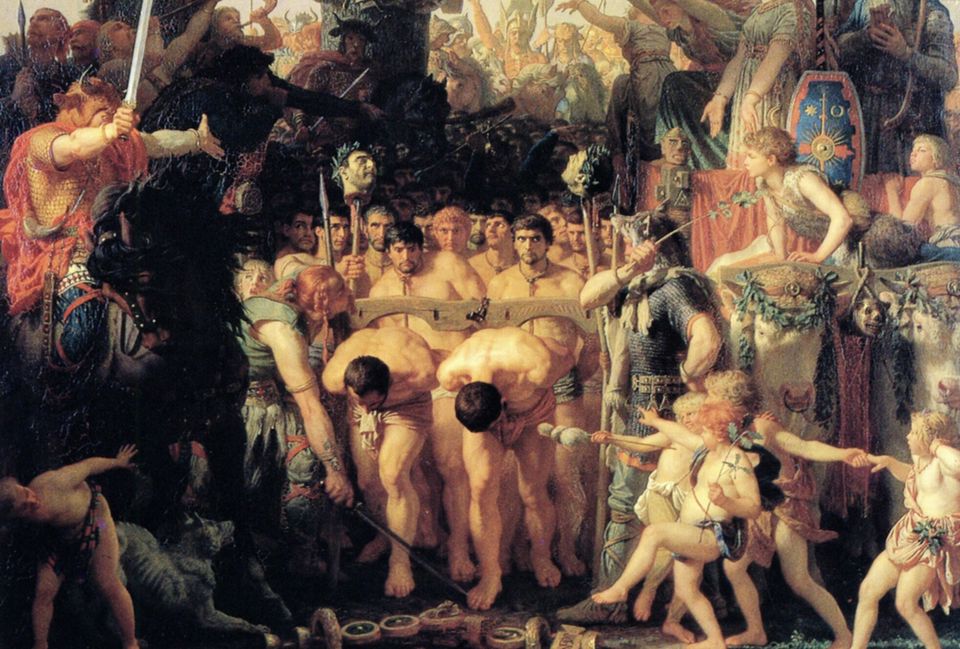The Petticoating of the West

"Soft countries breed soft men." - Herodontus ¹
History tends to repeat itself or, at the very least, rhyme. The common adage from Michael G. Hopf echoes this cyclical pattern in which empires rise and fall:
“Hard times create strong men. Strong men create good times. Good times create weak men. And, weak men create hard times.” - Michael G Hopf ²
One of the signs of hard times is the slow degradation of traditional norms. The forced masculinization of women to become arbiters is one example; the other is the forced feminization of men to become passive onlookers. But for any role reversal to occur, there needs to be a change in the overall perception of men and women, and something as innocuous as clothing can have a subtle but lasting impact. If so, there may be an inkling of truth behind the Latin proverb "clothes make the man," which begs the question—can they unmake him?
Indeed, wearing clothes is one of the few peculiarities that separate us as humans from the majority of the animal kingdom. Back in hunter-gatherer times, humans wore furs and hides to protect themselves from predators and to keep warm during harsh winter climates. As societies advanced, men’s attire became less about practical usage and more about displaying one’s status and authority to others within the social hierarchy without resorting to threats of physical violence. If clothes can influence one's status, can it also alter our perceptions of men and women? Or is it simply an optical illusion designed to confine us to restrictive notions of masculinity and femininity?
Consider male modeling and the fashion industry. Metrosexual men, urban males obsessed with their personal grooming and appearance, have been the face of men’s fashion since the early ‘90s. Known for their sexual ambiguity and self-indulgent attitude, they are typically considered an outgrowth of consumerist culture within societies that favor looser interpretations of gender roles. In this case, the traditional suit and tie drab machismo of the early 20th and 21st century has been stripped down and redressed to fit a more fab and free-flowing form of masculinity. And while gender-bending isn’t a new phenomenon, the use of mass advertising to publically emasculate and socially condition men from expressing conventionally masculine behaviors is. Here are some of the following examples in just the past few years:



Author and essayist, Karl Philip Moritz, noted that:
"The more solicitous any people are about dress, the more effeminate they are." - Karl Philipp Moritz ³
But violations against the predominant social order of any society for the sake of shock value eventually dissipate into mundane static. Deviant attire soon becomes normal as counter-culture fashionistas gain traction and influence, creating a new baseline of dress etiquette and, with it, arbitrary guidelines for how men and women should behave. Some might argue this as flawed logic, invoking the slippery slope fallacy as a counterpoint. However, major changes can occur through slow, unnoticeable ones as long as they are fairly inconsequential. Fashion and modeling are some of the best industries that can subtly shift perceptions of masculinity by gradually introducing transgressions against it without backlash, transforming it into something else entirely. We often underestimate the affect clothes have on our psyche until we witness its power firsthand.
Petticoating, for example, is a form of punishment that dates back to Victorian times, whereby adults forced boys to wear dresses as a form of humiliation to prevent future misconduct. Forced feminization is also a sexual paraphilia that has recently gained popularity in erotic literature. Still, could something as innocent as clothing be guilty of so much psychological harm?
A scientific study conducted in 2012 by Hajo Adam and Adam Galinsy might prove so. In their experiment, they tested whether or not clothes had any psychological effects on human cognitive behavior. To test this hypothesis, they had participants in the study divided into two groups. One group was given doctor’s coats to wear while the other group remained in their general attire. Both groups engaged in a Stroop test, an attention exercise, to see if there was any difference in performance. The results showed a substantial disparity in success between those who wore the doctor’s coats and those who didn’t. Later they conducted the same test but told participants it was a painter’s coat instead—still no improvement. They even had participants do the test within proximity of the coats but to no avail. They concluded, based on these observations, that our symbolic meaning of clothes, in addition to wearing them, does have an effect on our psychology beyond material priming, in what they refer to as “enclothed cognition.” ⁴
Given this information, it would not be too far of a stretch to believe that feminine clothing can psychologically castrate the masculine mind. In the 1970s, prisoners of the Stanford Prison Experiment were forced to wear smocks without any underclothes, similar to wearing a dress, as a form of humiliation. On their study’s official website, they state that “as soon as some of our prisoners were put in these uniforms, they began to walk and to sit differently, and to hold themselves differently.” ⁵ In comparison, in 2010, men in Maricopa County’s jail in Arizona were forced to wear pink underwear and have beds with pink bed sheets. In court proceedings against the county’s pink mandate, they claimed: “The color [was] chosen to symbolize a loss of masculine identity and power, to shame and stigmatize the male prisoners as feminine.”

Today, boys are taught to curb their natural boyishness and behave more like girls. Parents, especially mothers, conflate their sons’ natural rambunctiousness as a form of ADHD. And rather than let them express it, they quell it with prescribed medication. Boys today are not treated as boys but rather as defective little girls. The mass feminization of men through dress is a manifestation of male submission within consumer culture. Hence, why the Chinese government is banning its young and effeminate male stars, dubbed “little fresh meat”, from television and movies in order to revive masculinity in the East again. ⁶ Perhaps it’s time for the West to do the same before it’s too late. Because in any competition it is not the nice man who wins but the best man—no amount of clothing can cover up this naked truth.


